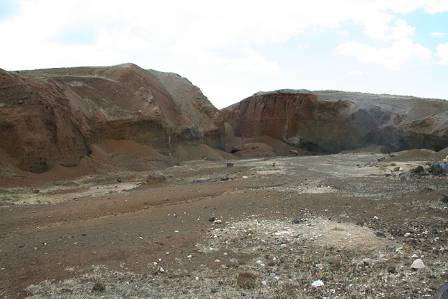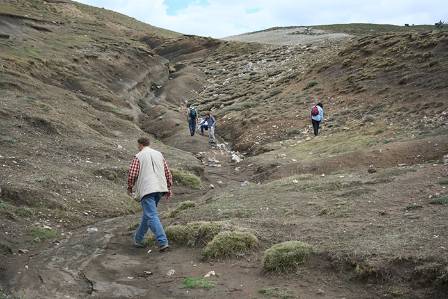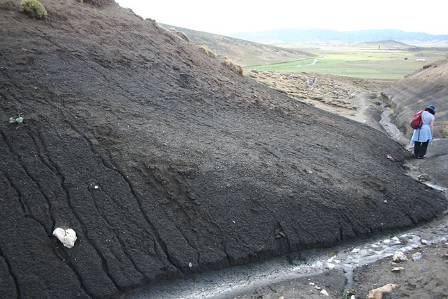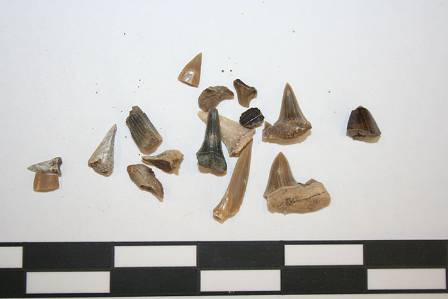On our second day in Morocco we had to pack our cases as we would be staying in a different hotel that night. Our team would also be splitting up to cover as many different sites and areas of interest as we could.
Desert driving
Our adventure to the first site was not without drama. We had three vehicles travelling in a convoy (I likened it to something from Top Gear - three Land Cruisers, traveling over amazing desert landscapes and each with its own personality) and an hour into our journey I had started to doze off. The next thing I knew I could smell burning - we had pulled up at the side of the road and were told to get out of the car immediately. It turned out our brakes had overheated and fused together.
There was a strong burning smell and some smoke. It wasn't anything major, but did mean we had to go down to two cars. All the luggage was transferred to the roof and seats put up in the boot and off we went again. It was a slightly more bumpy ride in the boot but all good fun. The adventures of an earth scientist!
On the way, we stopped to look at some monkeys in Cedar Forest, it was along a touristy trail so they were fairly tame and would steal your food if you gave them the chance. Many had infants attached to them, which were cute.
Monkey eating some bread in Cedar Forest.
Finally we reached the first stop, an extinct volcano site where analytical chemist Emma Humphreys-Williams wanted to collect some mantle xenoliths for her research. Mantle xenoliths are fragments of rock from depths of up to 50km, brought to Earth's surface through volcanism. We all got out the vehicles and spent a little time walking over the site looking at the volcanic rocks, which for me meant thinking back to my undergraduate degree in geology.
There were some lovely lava flows and volcanic tuff (basically consolidated volcanic ash). The xenoliths that we were looking for were a lovely green colour. My team were only there for about half an hour as most of the palaeontologists went onto Bakrit to look for more shark teeth. However, Emma HW, Zoe, Mark and Helena spent the day here. To find out more about what Emma and others did, check out the Brachiopod and Cephalopod collections blog!
Arriving at the volcano site, I thought it looked like something out of a Star Trek film.
After another hour's drive with quite a bit of bumpy off-roading (which I found quite fun) we reached our next site at Bakrit. Late Maastrichtian in age (last part of the Cretaceous period, about 70 million years ago) and an area rich in black organic deep water phosphate deposits. This is overlain by shallow-water limestone of unknown age (but is something we are working to determine) containing a diverse molluscan assemblage.
Searching for shark teeth
Bakrit is a site that both Charlie and David were very keen to look at as both had collected shark teeth from there before and wanted to add to their knowledge and increase diversity of the Museums collections. Again this site was great for just walking along and finding lots of shark teeth sticking out of the surface. Some of the most common shark teeth we found were Cretolamna and Squalicorax which belong to the same family as the Great White shark (Carcharodon carcharias).
At Bakrit walking up the exposure looking for shark teeth.
The very small lighter/whiter bits were small (0.5-1cm) shark teeth, Zerina is looking for some.
A small number of the shark teeth we found. The scale is 1cm.
After an hour or so at the site, where we took measurements and GPS co-ordinates for all the material we collected, we were back in the vehicles and back on the bumpy road to meet our other colleagues who had been at the mine for the afternoon. Then we made our way to our accommodation in Midelt.
Charlie currently has all the shark teeth and is working to identify them all. They will then be marked up and put into the collections in the Museum for people to research and use. It's likely that a couple of scientific papers will be published about the site at Bakrit and the fossils found there over the next year or so.
Keep checking back here for more updates about our trip and visit Zoe's blog to see what others got up to in the field!







